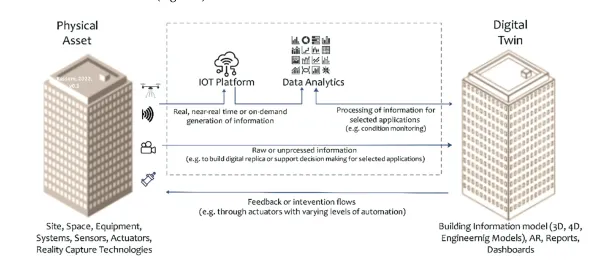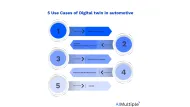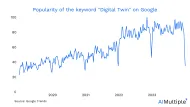Digital Twin Real Estate in '24: Best 5 Transforming Use Cases
Maintenance and utilities account for approximately 27 % of the operating expenses of a real estate firm. 1 Digital twins can help real estate companies cut operating costs by up to 35%, while improving living standards and fostering sustainability.
However, not all real estate executives and project and site managers are fully aware of what digital twins are and/or how they can help the real estate industry.
In this article, we will explain how digital twins can be used in real estate in the context of 5 use cases.
What is digital twin real estate?
A digital twin in real estate is a virtual representation of a building’s ecosystem, one with all the relevant information about the physical building and its environment.
What information do digital twins give in real estate?
The information that digital twins give can include:
- Heating, ventilation and air-conditioning (HVAC) systems data
- Building’s interior and exterior designs, such as floor plans, windows’ placement, etc.
- Facility management system data
- Facility security system data
- Lighting and fire sensor data
- Information about tenant interaction with building
From where do digital twins get their information from?
Digital twins collect data from:
- IoT devices and sensors that include operational data such as heating, air conditioning and ventilation unit
- Wireless sensor networks containing information on temperature, humidity and other factors
- IT systems such as maintenance management systems or tenant experience apps
- Digitized systems like smart plugs and elevator controls
- Third-party cloud services, if available.

We’ll discuss the top 5 use cases of digital twins in the real estate industry next.
1. Facilitate knowledge management
There are usually documents, drawings, and notes on the design and construction process of a building.
In the case of an emergency, the building manager has to consult these documents immediately to solve the issue, and not waste their time rifling through them.
Digital twins can streamline knowledge management in a cost and time-effective way. Digital twins contain/reflect all the information about a building, such as its design plan and also real-time data about their ecosystem.
Therefore, building/site managers can use digital twins to more easily pinpoint problematic areas to take action on. Accurate and timely diagnosis of issues results in fewer disruptions all around, which translates to higher resident satisfaction.
2. Enable fast and data-driven decision-making
Slow, low-quality decision-making leads to ill-designed strategies, causing project failures and even harming the company.
In real estate companies, decision-making is particularly difficult due to complex processes and heterogenous factors (e.g, changing market dynamics, new regulations, or environmental concerns).
Digital twins generate a 3D model of the real estate based on the collected data, showing the facade and interior of the building, such as floors, equipment activities, and systems.
The benefit of these simulations is their dynamism: anytime an adjustment is made in the real world, simulations reflect it. Thus, the real-time properties of a building are visible at all times.
This allows operators to measure the current and future performance of the building. For instance, operators can make changes to see how the model performance changes with the adding/removing of certain variables, such as safety and compliance levels, to forecast potential threats and prevent them.
As a result, building owners and operators can create fast and data-driven strategies.
For example, a large hospital in China created a digital twin of the hospital, which allowed the hospital to achieve real-time visual management and predict facility or operational issues. The hospital ran the virtual replica for a year, reducing energy consumption and the number of repairs while enhancing maintenance.
3. Optimize the real estate development
Based on the insights gathered from the building’s simulations, operators can identify the areas to improve.
Note that digital twins can be programmed to simulate the real-time status of a building at any time, even during the construction phase.
This means operators can plan, visualize and monitor the building’s development to assess similarities between the ideal designed model and the ongoing project. For instance, operators can create a digital twin of the construction site and monitor the equipment and material management.
Once operators gain a fuller knowledge of the construction process, conditions, and environment, they can improve productivity and optimize operations and safety of the workers and tools.
With digital twins, contractors can ensure that relevant materials are available in stores and arrive on time, by monitoring their delivery status in real time.
4. Reduce operating cost
Operating costs include the money spent on utilities, maintenance, and repairs. For instance, 10 to 15 % of operating costs are related to electricity, and 50-70% of electricity cost is due to lighting and HVAC systems.
Digital twins can bring visibility to these systems to shed light on, for instance, the role that tenants play in emissions. The building owners or managers can, then, use the insights to prepare efficient HVAC, and lighting systems management.
A benefit of digital twins is that they allow operators to monitor the facility on their smartphones or tablets and identify the exact point where the problem occurs. So operating costs can be cut and optimized from anywhere without sacrificing tenant satisfaction.
For example, a real estate investment company based in New York tracked the cost of HVAC systems for a year by generating a digital twin of their estates. Consequently, the firm developed an efficient operating cost structure and saved $ 170,000. 2
5. Foster sustainability
Real estate holds 40% of global carbon emissions and produces waste rounding up to 2.2B tons. 3Such high environmental damage calls for better sustainable management.
The digital twin real estate model can allow buildings and site managers to improve their corporate sustainability. With digital twins of the buildings’ ecosystems, managers can monitor CO2 emissions, pollution, and waste collection at the building. The designers can simulate different scenarios and calculate the outcome of any change in their models, such as replacing energy systems with a more sustainable option.
Today, some governments encourage leveraging digital twins for planning environmentally friendly or green real estate projects in the context of smart cities.
For instance, Singapore initiated a digital twin smart district project to reduce energy consumption while improving residents’ living standards through sustainable, faster, and easier transportation systems (see the video below for more). 4
Learn more about the top 5 ways by which AI can improve the sustainability of your business.
Further reading
Explore other digital twins’ use cases and tools to leverage with:
- 15 Digital Twin Applications/ Use Cases by Industry
- 5 Ways to Harness the Power of Process Mining and Digital twins
- Top 9 Use Cases of Digital Twin of an Organization (DTO)
If you believe your business can benefit from process intelligence tools and digital twins technology, check out our data-driven comprehensive vendor lists for DTO, Process Mining, and Task Mining software.
And, if you have more questions, you can always contact us:
External Links
- 1. “2021 Price Index of Operating Costs.” NY city Rent Guidelines Board. 2021. Revisited January 6, 2023.
- 2. “Increasing NOI In Stabilized Class A Office High Rise.” Enertiv. Revisited January 6, 2023.
- 3. “Real Estate Predictions.” Deloitte. 2021. Revisited January 6, 2023.
- 4. “Singapore’s most highly anticipated smart district.” IJT. Revisited January 6, 2023.



Comments
Your email address will not be published. All fields are required.